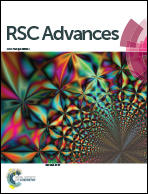Heteroatom-doped hollow carbon spheres made from polyaniline as an electrode material for supercapacitors
Abstract
In this work, novel heteroatom-doped hollow carbon spheres (HHCSs) were prepared via the carbonization of polyaniline hollow spheres (PHSs), which were synthesized by one-pot polymerization. It was found that the carbonized PHSs at 700 °C exhibit high specific capacitance of 241 F g−1 at a current density of 0.5 A g−1 and excellent rate capability. The excellent electrochemical performance can be attributed to the heteroatom-doping and hollow carbon nanostructure of the HHCSs electrodes. Heteroatom groups in the HHCSs not only improve the wettability of the carbon surface, but also enhance the capacitance by addition of a pseudocapacitive redox process. Their unique structure provides a large specific surface area along with reduced diffusion lengths for both mass and charge transport.



 Please wait while we load your content...
Please wait while we load your content...